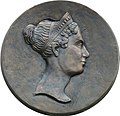Catherine Pavlovna

Catherine Pavlovna Romanova, Grand Duchess of Russia ( Russian Екатерина Павловна Романова) from the House of Romanov-Holstein-Gottorp (born May 10, jul. / 21st May 1788 greg. In Tsarskoye Selo ; † 9. January 1819 in Stuttgart ) was from 1816 until 1819 Queen of Württemberg after her husband took office on October 30, 1816.
Life
Grand Duchess Katharina Pavlovna was a daughter of Russian Tsar Paul (1754-1801) and his wife Marija Fjodorovna (née Sophie Dorothee, Duchess of Württemberg , 1759-1828). She had nine siblings, including the later Tsars Alexander I and Nicholas I.
According to the alliance and marriage contract concluded on October 1, 1799 at Gatchina Palace near St. Petersburg between the Electoral Palatinate of Bavaria and Russia , she was supposed to meet the Bavarian electoral prince Ludwig (son of Elector Max IV Joseph of Bavaria, from 1825 King Ludwig I. from Bavaria ). The marriage project met with decided opposition in the following years, in particular Napoleon , who himself intended to marry her, whereas Alexander's mother's attitude towards Napoleon stood against, which is why both marriages ultimately did not materialize. On August 3, 1809, she married Duke Georg von Oldenburg , who died of typhoid fever in 1812 after only a few years of marriage. Totally desperate and in great sadness, Katharina collapsed on his deathbed and fell seriously ill. The symptoms appeared to be of a more psychological nature - with daily fainting spells and often prolonged rigidity. She was probably suffering from catatonia .
In her second marriage, Katharina married her cousin, Crown Prince Wilhelm (1781–1864) of Württemberg, in Saint Petersburg on January 24, 1816 . The marriage came about at the Congress of Vienna in 1815, not least to improve the relationship between Württemberg, which was on the Napoleonic side, and its former opponents, Russia, Austria and Prussia.
Shortly after the marriage, her husband took over as King Wilhelm I in October 1816 in a time of need (crop failures, high prices, famine in Württemberg). Queen Catherine unfolded extensive charity work.
She became known through the founding of the "Central Charity Association", in which she worked together with middle-class men and women to alleviate hardship. Numerous other institutions, for example the Katharinenstift and the Katharinenhospital in Stuttgart , the Württembergische Landessparkasse and the welfare organization for Baden-Württemberg go back to them.
Katharina died surprisingly in January 1819. When she found out that Wilhelm I was not ready to give up his relationship with the Italian noblewoman Blanche de la Flèche (Baroness Keudelstein) († 1864), the queen went - wearing only a thin dress - Followed them to the Royal Private Stud in Scharnhausen , where she caught the flu in the winter cold. The disease was aggravated by shingles , which Katharina had suffered from since November 1818. The medical bulletin and the report on the section carried out give clear information on the cause of death. She had already caught a cold on January 3, 1819, but the next day she wanted to take a carriage ride to see the king in Scharnhausen. In addition, a sore had formed in the corner of her mouth, which she pierced herself. A bacterial infection developed. This rose wound led to a vascular occlusion in the brain, as the dissection of the skull has confirmed. Katharina died of a stroke at half past seven in the morning . The doctor's report notes: “IM spoke unhindered about various objects at 7am. After that, however, she passed out, her pulse weakened and she died. "
King Wilhelm I had a mausoleum ( grave chapel ) built for his wife on Württemberg near Stuttgart , in which she was buried in 1824. On his portal it is written: "Love never stops".
Katharina Pavlovna, bust in the burial chapel on the Rotenberg
Katharina Pawlowna, painting in the Ludwigsburg residential palace
Katharina Pawlowna, obelisk in the Hohenheim Gardens
progeny
Two sons from her first marriage to Duke Georg von Oldenburg :
- Peter Georg Paul Alexander (born August 30, 1810 - † November 16, 1829)
- Konstantin Friedrich Peter (born August 26, 1812 - † May 14, 1881)
Two daughters from her second marriage to King Wilhelm I of Württemberg :
- Marie Friederike Charlotte (born October 30, 1816 - † January 4, 1887) ⚭ 1840 Count Alfred von Neipperg
- Sophie Friederike Mathilde (June 17, 1818 - June 3, 1877) ⚭ 1839 King Wilhelm III. the Netherlands
literature
- Jakob Merkle: Katharina Pawlowna, Queen of Württemberg. Contributions to a biography of the princess, especially according to more recent Russian sources. Stuttgart 1889.
- Max Rehm: Queen Katharina of Württemberg. Your life and work according to personal testimonies and in the mirror of contemporaries. Stuttgart 1968.
- Catharina Pawlowna, Queen of Württemberg 1816–1819. Influences - Life - Achievements. Exhibition catalog Hohenheim 1993.
- Otto-Heinrich Elias : Remarks on the biography of Queen Catherine of Württemberg. In: Wolfgang Schmierer u. a .: From southwest German history. FS Hans-Martin Maurer. Stuttgart 1994, pp. 595-615.
- Eberhard Fritz: King Wilhelm and Queen Catherine of Württemberg. Studies on courtly representation in the mirror of the court diaries. In: Journal for Württemberg State History. 54/1995, pp. 157-177.
- Detlef Jena: Katharina Pawlowna. Grand Duchess of Russia - Queen of Württemberg. Regensburg 2003.
- Sabine Thomsen: The queens of Württemberg. Charlotte Mathilde, Katharina, Pauline, Olga, Charlotte - their life and work. Silberburg 2010, ISBN 978-3-87407-714-9 .
Web links
- Catherine Pavlovna of Russia - Queen of Württemberg
- Catharina Pavlovna Society V.
- PN Petrov: Catalog of historical portrait exhibitions (Каталог исторической выставки портретов), Saint Petersburg 1870, p. 173 (Russian)
- IS Semjonow: Christian Dynasties in Europe (Христианские династии Европы), Olma Media Group, 2002, p. 185 (Russian)
- Works by and about Katharina Pawlowna in the German Digital Library
- Maaike van Rijn: Katharina Pawlowna Romanowa, Queen of Württemberg (1788-1819). published on April 19, 2018 in: Stadtarchiv Stuttgart: Stadtlexikon Stuttgart.
Individual evidence
- ↑ a b Location: South of Hohenheim Castle above the vineyard near Station 15. Inscriptions (clockwise): Catharina Pawlowna | Queen of Württemberg | Grand Duchess of Russia | May 21, 1788 Tsarskoye Selo | Jan. 9, 1819 Stuttgart | In times of full night she walked beneath us, glowing and warming. Until the sun came again, they went [sic!]. - Wife of King Wilhelm I of Württemberg 1781–1864 | Daughter of Tsar Paul I of Russia 1754–1801 and Sophie Dorothea of Württemberg 1759–1828 born of Tsarina Maria Feodorovna | Wherever she entered, there was also light and happiness. - Wife of Prince Georg von Oldenburg 1784–1812 | Granddaughter of Tsarina Catharina II of Russia 1729–1796 and of Duke Friedrich Eugen von Württemberg 1732–1797 | I have to work as long as it is day. The night comes when no one can work. - Württembergische Spar-Casse | Central Office of the Agricultural Association | Agricultural Institute Hohenheim | Central point of the charity Queen-Katharina-Stift | Russian Orthodox Community | Katharinenhospital | Catharina's life has not disappeared without a trace. It continues in its seeds. | Donated by the Baden-Württembergische Bank 2008 | M. Wolf fecit [lat .: did it]
- ^ Albrecht Liess: The marriage project of Crown Prince Ludwig of Bavaria with the Russian Emperor's daughter Katharina in the conflict between the great powers 1799-1808. In: Festschrift Hermann Rumschöttel for the 65th birthday. (= Archival Journal. Volume 88.1). Volume 1, Böhlau Verlag, Cologne / Weimar / Vienna 2006, DNB 981733530 , pp. 525–555.
- ↑ See Otto-Heinrich Elias , Queen Katharina
- ↑ Sabine Thomsen: The Württemberg queens: Charlotte Mathilde, Katharina, Pauline, Olga, Charlotte - their life and work. Silberburg, 2010, ISBN 978-3-87407-714-9 .
| personal data | |
|---|---|
| SURNAME | Catherine Pavlovna |
| ALTERNATIVE NAMES | Queen Catherine of Württemberg |
| BRIEF DESCRIPTION | Queen of Württemberg |
| DATE OF BIRTH | May 21, 1788 |
| PLACE OF BIRTH | Tsarskoye Selo |
| DATE OF DEATH | January 9, 1819 |
| Place of death | Stuttgart |






